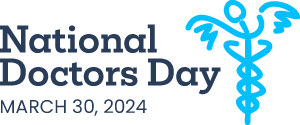
NATIONAL DOCTORS DAY 2024
All About Doctors Day
We celebrate National Doctors Day in America on March 30 each year, honoring the dedication and compassion displayed daily by more than one million physicians providing healthcare to patients nationwide.
These healers are the heart of the American healthcare system. In the US, doctors provide care to over 1 billion patients yearly, with an average of 3.2 doctor visits per person — 50% of those visits are made to a primary care physician. This country has had a persistent physician shortage in recent years, and experts predict a shortage of between 37,800 and 124,000 physicians by 2034. Our doctors are feeling the heavy demands placed on them daily by the healthcare industry. Most doctors work over 50 hours a week, and many work 80-plus.
If anybody has earned a day of appreciation, it is our doctors. Without their efforts and courage in the face of adversity, our country would be much worse for the wear. Without an adequate supply of doctors, healthcare systems are left with significant strain, leading to longer patient wait times, increased workloads for existing medical staff, and an overall reduced quality of care. In such scenarios, there’s often a greater reliance on locum tenens physicians and other locums providers. We need doctors and want them to know how important they are to each of us.
NationalDoctorsDay.org is here as a resource, with tools to help healthcare staffing agencies celebrate and recognize their doctors. Join us by honoring the dedicated physicians who improve our lives this National Doctors Day, and utilize our marketing toolkit to facilitate your company’s marketing outreach to doctors and the healthcare industry.
A Brief History of Doctors Day
The origin of National Doctors Day dates back 90 years to Winder, Georgia, a community with 18,000 residents just outside the city of Atlanta. In 1933, Eudora Brown Almond, the wife of a family medicine physician, Dr. Charles B. Almond, felt doctors deserved a little extra recognition in American society for their extraordinary, life-saving, and often thankless work.
Almond turned to her fellow citizens in rural Georgia to send greeting cards to each of their physicians and lay flowers on the graves of late physicians. March 30 was not chosen at random. The day of observance for National Doctors Day was picked to commemorate the first use of anesthesia during surgery in 1842 by physician Dr. Crawford Long, a well-known doctor from Jefferson, Georgia.
On March 30, 1958, Congress adopted a resolution commemorating March 30 as National Doctors Day after the movement gained traction in the medical community over two decades.
In 1990, President George H.W. Bush designated National Doctors Day an official day of recognition by the US government. These days, doctors’ contributions are celebrated nationwide on March 30 and around the world by employers, co-workers, and patients of physicians.
Since National Doctors Day’s founding, the traditions once introduced by Almond to the Winder community have evolved a bit — from hand-written, personalized greeting cards to posts made on social media, where more and more people can show their appreciation for their physicians. Healthcare facilities and physician staffing agencies typically showcase their appreciation for doctors in digital and print marketing campaigns.
The medical field has changed vastly since National Doctors Day’s first celebration. An increasing number of women are pursuing careers in medicine, and there is a greater representation of diversity among physicians and a wider range of specialties attracting more medical students. Also, 47% of physicians are 55 and older.
Our doctors’ dedication has remained constant despite the changes in the medical community. Many doctors say that the connection they build with their patients is one of the most rewarding parts of their job. Physicians are entrusted to hold other human beings’ lives in their hands. As we navigate the evolving healthcare landscape, let’s use National Doctors Day to let doctors know we see them, appreciate them, and wholeheartedly support them.
Facts & Stats about Doctors
Here are some interesting facts and statistics about doctors in the United States that you might not know.
Physicians played an important role in the formation of this country. John Morgan, Joseph Warren, the director general of the Medical Department of the US Continental Army, and Benjamin Rush were all pivotal figures in establishing medical practice in America. Rush actually signed the Declaration of Independence.
John Morgan, who had earned his medical degree at the University of Edinburgh, founded the first medical school in the country, which is now part of the University of Pennsylvania.
Before creating dedicated medical schools, doctors learned by apprenticeship.
The average age of a doctor is 54, compared to a median age of 42 across other professions.
62% of all doctors are male, while 38% are female
Physicians had an average salary of $350,000 a year.
About 52,000 doctors work as locum tenens physicians across the U.S.
Doctors typically see 20 to 30 patients a day.
20,920 U.S. medical school students graduated in 2023.
Top US States for Active Physicians (2023)
No Data Found
Distribution of Physicians by Specialities
Loading..........
The Data is Not Available

